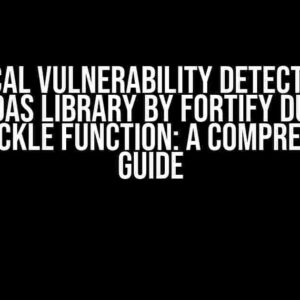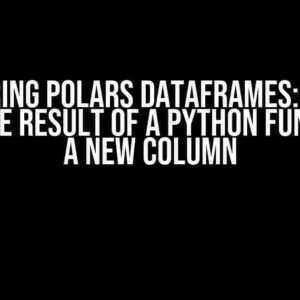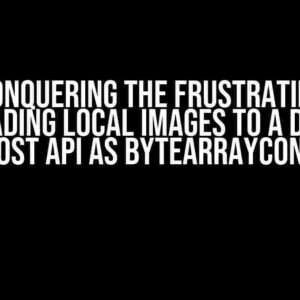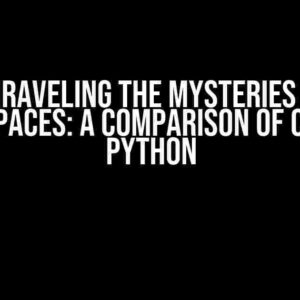Are you tired of encountering the frustrating Python error “TypeError: byte indices must be integers or slices, not str” when trying to access or manipulate bytes in your Python script? You’re not alone! This error can be perplexing, especially for beginners. Fear not, dear Python enthusiast, for we’re about to dive into the world of bytes, indices, and slices to demystify this error once and for all.
What is a TypeError in Python?
A TypeError in Python occurs when you attempt to perform an operation on a variable or object using an incorrect or incompatible data type. In the case of our error, the TypeError is raised because Python is complaining about the type of index used to access bytes.
Bytes and Indices: A Brief Introduction
In Python, bytes are a sequence of integers in the range 0 <= x < 256. They are often used to represent raw binary data, such as images, audio, or encrypted information. When working with bytes, you can access individual elements using indices, which are integers that specify the position of the element in the sequence.
my_bytes = b'Hello, World!'
print(my_bytes[0]) # Output: 72 (ASCII code for 'H')
Slices, on the other hand, allow you to extract a subset of elements from the bytes sequence. You can specify a range of indices using the slice notation, `my_bytes[start:stop:step]`. For example:
my_bytes = b'Hello, World!'
print(my_bytes[0:5]) # Output: b'Hello'
Why Does the Error “TypeError: byte indices must be integers or slices, not str” Occur?
The error “TypeError: byte indices must be integers or slices, not str” occurs when you try to access or manipulate bytes using a string index instead of an integer or slice. This can happen in various scenarios:
- Assigning a string to an index: `my_bytes[‘Hello’] = b’World’`
- Using a string as an index in a slice: `my_bytes[‘0’: ‘5’]`
- Passing a string as an argument to the `index()` method: `my_bytes.index(‘Hello’)`
In each of these cases, Python raises a TypeError because strings are not valid indices for bytes. You can only use integers or slices to access or modify bytes.
Solutions to the Error “TypeError: byte indices must be integers or slices, not str”
Now that we’ve explored the causes of this error, let’s dive into the solutions!
Solution 1: Use Integer Indices
If you need to access a specific element in the bytes sequence, use an integer index:
my_bytes = b'Hello, World!'
print(my_bytes[0]) # Output: 72 (ASCII code for 'H')
Solution 2: Use Slices
For extracting a range of elements from the bytes sequence, use slices:
my_bytes = b'Hello, World!'
print(my_bytes[0:5]) # Output: b'Hello'
Solution 3: Convert Strings to Bytes
If you need to search for a specific string within the bytes sequence, convert the string to bytes using the `encode()` method:
my_bytes = b'Hello, World!'
search_string = 'Hello'
search_bytes = search_string.encode()
print(my_bytes.find(search_bytes)) # Output: 0
Solution 4: Avoid Using Strings as Indices
When working with bytes, avoid using strings as indices or in slice notation. Instead, use integers or slices explicitly:
my_bytes = b'Hello, World!'
# Incorrect: my_bytes['0': '5']
# Correct: my_bytes[0:5]
Best Practices for Working with Bytes in Python
To avoid the “TypeError: byte indices must be integers or slices, not str” error and ensure smooth sailing when working with bytes, follow these best practices:
- Use consistent indexing: Stick to integer indices or slices when working with bytes.
- Convert strings to bytes: When searching for strings within bytes, convert the string to bytes using `encode()`.
- Avoid implicit conversions: Be mindful of implicit conversions between strings and bytes. Use explicit conversions instead.
- Test your code thoroughly: Verify your code’s behavior with different inputs and edge cases to catch any potential errors.
| Scenario | Correct Approach | Incorrect Approach |
|---|---|---|
| Accessing a single element | `my_bytes[0]` | `my_bytes[‘0’]` |
| Extracting a range of elements | `my_bytes[0:5]` | `my_bytes[‘0’: ‘5’]` |
| Searching for a string | `my_bytes.find(search_bytes)` | `my_bytes.find(search_string)` |
By following these guidelines and understanding the difference between bytes, indices, and slices, you’ll be well on your way to mastering bytes manipulation in Python.
Conclusion
The “TypeError: byte indices must be integers or slices, not str” error is a common stumbling block for Python developers. By grasping the underlying concepts of bytes, indices, and slices, you can overcome this error and work efficiently with bytes in your Python scripts. Remember to use integer indices or slices, convert strings to bytes when necessary, and test your code thoroughly to avoid this error.
Now, go forth and conquer the world of bytes in Python!
Frequently Asked Question
Get the lowdown on the Python error “TypeError: byte indices must be integers or slices, not str” with our expert Q&A session!
What is causing the “TypeError: byte indices must be integers or slices, not str” error in Python?
This error occurs when you’re trying to access a byte string using a string index, which is not allowed in Python. Byte strings can only be indexed using integers or slices, not strings. For example, if you have a byte string `b = b’hello’` and you try to access it like `b[‘0’]`, you’ll get this error. Instead, you should use `b[0]` to access the first byte.
How do I fix the “TypeError: byte indices must be integers or slices, not str” error in Python?
To fix this error, you need to make sure you’re using integer indices or slices to access your byte string. If you’re trying to access a specific byte, use an integer index like `b[0]`. If you’re trying to access a range of bytes, use a slice like `b[0:5]`. You can also use the `ord()` function to convert a single character to an integer index, like `b[ord(‘h’)]`.
Can I use a string index to access a byte string in Python 2.x?
Ah, Python 2.x nostalgia! In Python 2.x, strings and byte strings were not clearly distinguished, and you could get away with using string indices to access byte strings. However, this is no longer the case in Python 3.x, where the distinction between strings and byte strings is more strict. So, if you’re using Python 3.x, you need to stick to integer indices or slices.
What is the difference between a string and a byte string in Python?
In Python, a string (type `str`) is a sequence of Unicode characters, while a byte string (type `bytes`) is a sequence of bytes. Byte strings are used to represent raw binary data, like the contents of a file or a network packet. Strings, on the other hand, are used to represent human-readable text. When you need to work with binary data, you should use byte strings, and when you need to work with text, you should use strings.
How do I convert a string to a byte string in Python?
Easy one! To convert a string to a byte string, you can use the `encode()` method, like this: `b = s.encode(‘utf-8’)`. This will encode the string `s` using the UTF-8 encoding scheme and return a byte string `b`. Conversely, you can use the `decode()` method to convert a byte string to a string, like this: `s = b.decode(‘utf-8’)`.





